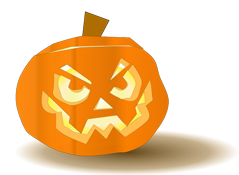The Orcs is a presentation that we worked during the Castanyada Season 2010. It has been seen at school already, but you can enjoy it once again.
Monday, October 28, 2013
Halloween Fun
If you want to have fun this Halloween, just click on the links and try a lot of on-line games at:

First, you can create your how scary story clicking here.
Secondly, send a free Halloween eGreeting card to a mate, a friend and family...

The Witch and the Cat (Halloween Story)
Once upon a time a cat fell in love with a handsome young man. The cat went to a witch and asked her to change her into a pretty young woman, so that she might marry the young man.
The witch agreed, for she cared nothing for the young man, or whom he married.
The cat, who was now a pretty girl, moved into the cottage next to the young man's home and soon they were engaged to be married.
However, the boy's mother, who knew something of witchcraft, did not like the girl. She did not like her green eyes which had black slits like cat's eyes, instead of round pupils as ordinary humans have.
The mother suspected that the girl was really a cat and told her son. However, he would hear nothing against his sweetheart and said his mother was merely jealous.
Determined that her son should not marry a cat, the mother waited until the whole family was seated in the parlour, then she let loose a mouse to run across the room. Immediately the girl, forgetting she was a young lady and only remembering her cat's feelings, pounced on the mouse and shook it in her mouth.
The Kingdom of Witches
The Kingdom of Witches
At the end of the world
On an island alone,
Lies a city of secrets,
Mortar and stone.
Surrounded by serpents,
Spirits and spells,
The Kingdom of Witches
In mystery dwells.
Through the dungeons and ditches,
Strange shadows and lights
Fill the nooks and the niches
With unearthly sights.
Sultans and sages
From Karth and Darbeen,
Seek the counsel and favor
Of the Witch King and Queen.
Squadrons of crones
On brooms to and fro,
Fly cackling on errands
To the city below.
Each witch house and hut
Holds thrills, chills, and frights,
And plots, pits, and perils,
On long witchy nights.
So, if you would learn
Of each hex, curse, and potion,
And the march of the dead
At the end of the ocean
Then set you a course
To where no compass tells,
And the Kingdom of Witches
In mystery dwells.
Halloween Vocabulary
If you want to learn the main vocabulary for the Halloween Holiday, take a look at this presentation:
Halloween Facts

Halloween falls on the 31st October of every year and is a time when
people dress in scary costumes, go trick or treating and play traditional
Halloween games, such as apple bobbing.
Halloween involves a variety of traditions from different cultures and
religions and there are many interpretations of these.
The word Halloween is a modern interpretation of its original name, All
Hallow's Eve. The first day of November was traditionally celebrated by the
Catholic Church as All Hallow's Day when they took time to pay their respects
to the saints.
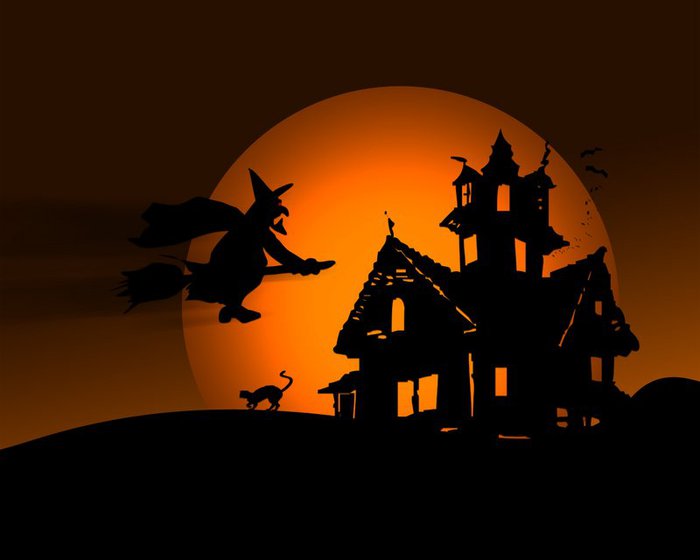
The date of Halloween, 31st October, marked the end of the Celtic year
and was believed to be the day when the spirits of those who died in the
previous year would come back and possess a body of the living to allow
themselves into the afterlife. However, the people who were living were not
keen on being possessed and would dress up in scary costumes to try and
frighten away spirits.
How did the tradition of trick or treating come about?
Trick or treating nowadays involves dressing up in costumes and knocking on neighbours doors for treats. If treats are not given then tricks are played on the neighbour. Trick or treating is thought to have come from a traditional European
custom called 'souling'. It is believed that Christians used to go from door to
door in villages to ask for soul cakes and for every cake you gave them they
would say a prayer for one of your dead relatives.
What is apple bobbing and where does it come from?
The Romans used to celebrate Pomona, their goddess of fruit, in October
and the symbol for Pomona was an apple. It is believed that this is where the
Halloween tradition of apple bobbing comes from.
Where does the name Jack O'Lantern originate from?
Carving a face in a pumpkin and placing a candle inside is to represent
the Irish folklore about a man called Jack. It is thought that Jack was a
notorious trickster and once even managed to trap Satan up a tree. When Jack
died, he was refused from heaven because of his bad behaviour and as revenge;
Satan refused Jack entry into hell, but gave him a single ember to guide him
through the darkness. The ember was said to be placed inside a turnip to make
it last longer. Over time the turnip has changed to a pumpkin.

Monster Mash
To celebrate Halloween 2012, why not to listen to this song by Bobby "Boris" Pickett and watch this amazing video clip...
Let's have an eye on the lyrics:
I was working in the lab late one night
When my eyes beheld an eerie sight For my monster from his slab began to rise And suddenly to my surprise He did the mash He did the monster mash The monster mash It was a graveyard smash He did the mash It caught on in a flash He did the mash He did the monster mash From my laboratory in the castle east To the master bedroom where the vampires feast The ghouls all came from their humble abodes To get a jolt from my electrodes They did the mash They did the monster mash The monster mash It was a graveyard smash They did the mash It caught on in a flash They did the mash They did the monster mash The zombies were having fun The party had just begun The guests included Wolf Man Dracula and his son
The scene was rockin', all were digging the sounds
Igor on chains, backed by his baying hounds The coffin-bangers were about to arrive With their vocal group, "The Crypt-Kicker Five" |
They played the mash
They played the monster mash The monster mash It was a graveyard smash They played the mash It caught on in a flash They played the mash They played the monster mash Out from his coffin, Drac's voice did ring Seems he was troubled by just one thing He opened the lid and shook his fist And said, "Whatever happened to my Transylvania twist?" It's now the mash It's now the monster mash The monster mash And it's a graveyard smash It's now the mash It's caught on in a flash It's now the mash It's now the monster mash Now everything's cool, Drac's a part of the band And my monster mash is the hit of the land For you, the living, this mash was meant too When you get to my door, tell them Boris sent you Then you can mash Then you can monster mash The monster mash And do my graveyard smash Then you can mash You'll catch on in a flash Then you can mash Then you can monster mash |
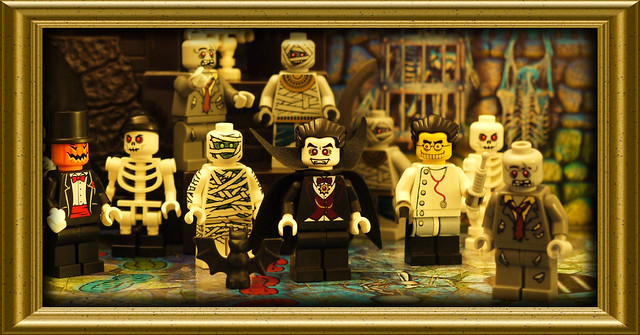
Halloween Orange
A different way to carve a scary Halloween decoration. Try if you want, the results are impressive!
Halloween's Short History
The word Halloween comes from the ancient Celtic expression All Hollows Eve, that is: the night before the Day of the Dead.
The Celtic people lived in the areas which are now Great Britain and Northern France more than 2,000 years ago.
November 1 was considered New Year’s Day, among the Celts and this holiday was calledSamhain, honouring Samhain who was the lord of the dead and of the cold, dark winter season.
The Celts believed that on All Hollows Eve night the spirits of all those who had died come back in search of living bodies to possess for the next year. So they built huge sacred bonfires, where the people gathered to burn crops and animals as sacrifices; and dressed up in scary costumes and run through the streets holding torches and making noise to confuse the spirits.
Halloween is an old tradition in Ireland and Scotland. In those countries, people dressed up and carried lanterns made of turnips. When people moved from Ireland and Scotland to the United States in the 1840’s, they started using pumpkins because there were no turnips in The United States. This is where the Jack O’Lantern tradition comes from.
Friday, October 25, 2013
The Nightmare before Christmas
The Nightmare Before Christmas is a 1993 film directed by Henry Selick and produced/co-written by Tim Burton. It tells the story of Jack Skellington, a being from Halloween Town who opens a portal to Christmas Town.
Jack Skellington, the pumpkin king of Halloween Town, is bored with doing the same thing every year for Halloween. One day, he takes a walk into the woods and discovers some trees with different doors representing various holidays. The Christmas Tree door attracts his attention so he comes into the world of Christmas. Christmas Town is amazing to Jack, so he decided to share it with the citizens of Halloween Town, and they decide to make their own Christmas celebration. The problem is that they can't get it quite right...


One of the most famous cuts from this film is This is Halloween. Watch the clip:
Here you are the lyrics of the song:
[SHADOW]
Boys and girls of every age
Wouldn't you like to see something strange?
[SIAMESE SHADOW]
Come with us and you will see
This, our town of Halloween
[PUMPKIN PATCH CHORUS]
This is Halloween, this is Halloween
Pumpkins scream in the dead of night
[GHOSTS]
This is Halloween, everybody make a scene
Trick or treat till the neighbors gonna die of fright
It's our town, everybody screm
In this town of Halloween
[CREATURE UNDER THE BED]
I am the one hiding under your bed
Teeth ground sharp and eyes glowing red
[MAN UNDER THE STAIRS]
I am the one hiding under yours stairs
Fingers like snakes and spiders in my hair
[CORPSE CHORUS]
This is Halloween, this is Halloween
[VAMPIRES]
Halloween! Halloween! Halloween! Halloween!
In this town we call home
Everyone hail to the pumpkin song
[MAYOR]
In this town, don't we love it now?
Everybody's waiting for the next surprise
[CORPSE CHORUS]
Round that corner, man hiding in the trash cam
Something's waiting no to pounce, and how you'll...
[HARLEQUIN DEMON, WEREWOLF & MELTING MAN]
Scream! This is Halloween
Red 'n' black, slimy green
[WEREWOLF]
Aren't you scared?
[WITCHES]
Well, that's just fine
Say it once, say it twice
Take a chance and roll the dice
Ride with the moon in the dead of night
[HANGING TREE]
Everybody scream, everbody scream
[HANGED MEN]
In our town of Halloween!
[CLOWN]
I am the clown with the tear-away face
Here in a flash and gone without a trace
[SECOND GHOUL]
I am the "who" when you call, "Who's there?"
I am the wind blowing through your hair
[OOGIE BOOGIE SHADOW]
I am the shadow on the moon at night
Filling your dreams to the brim with fright
[CORPSE CHORUS]
This is Halloween, this is Halloween
Halloween! Halloween! Halloween! Halloween!
Halloween! Halloween!
[CHILD CORPSE TRIO]
Tender lumplings everywhere
Life's no fun without a good scare
[PARENT CORPSES]
That's our job, but we're not mean
In our town of Halloween
[CORPSE CHORUS]
In this town
[MAYOR]
Don't we love it now?
[CORPSE CHORUS]
Skeleton Jack might catch you in the back
And scream like a banshee
Make you jump out of your skin
This is Halloween, everyone scream
Wont' ya please make way for a very special guy
Our man jack is King of the Pumpkin patch
Everyone hail to the Pumpkin King
[EVERYONE]
This is Halloween, this is Halloween
Halloween! Halloween! Halloween! Halloween!
[CORPSE CHILD TRIO]
In this town we call home
Everyone hail to the pumpkin song
[EVERYONE]
La la-la la, Halloween! Halloween! [Repeat]
Boys and girls of every age
Wouldn't you like to see something strange?
[SIAMESE SHADOW]
Come with us and you will see
This, our town of Halloween
[PUMPKIN PATCH CHORUS]
This is Halloween, this is Halloween
Pumpkins scream in the dead of night
[GHOSTS]
This is Halloween, everybody make a scene
Trick or treat till the neighbors gonna die of fright
It's our town, everybody screm
In this town of Halloween
[CREATURE UNDER THE BED]
I am the one hiding under your bed
Teeth ground sharp and eyes glowing red
[MAN UNDER THE STAIRS]
I am the one hiding under yours stairs
Fingers like snakes and spiders in my hair
[CORPSE CHORUS]
This is Halloween, this is Halloween
[VAMPIRES]
Halloween! Halloween! Halloween! Halloween!
In this town we call home
Everyone hail to the pumpkin song
[MAYOR]
In this town, don't we love it now?
Everybody's waiting for the next surprise
[CORPSE CHORUS]
Round that corner, man hiding in the trash cam
Something's waiting no to pounce, and how you'll...
[HARLEQUIN DEMON, WEREWOLF & MELTING MAN]
Scream! This is Halloween
Red 'n' black, slimy green
[WEREWOLF]
Aren't you scared?
[WITCHES]
Well, that's just fine
Say it once, say it twice
Take a chance and roll the dice
Ride with the moon in the dead of night
[HANGING TREE]
Everybody scream, everbody scream
[HANGED MEN]
In our town of Halloween!
[CLOWN]
I am the clown with the tear-away face
Here in a flash and gone without a trace
[SECOND GHOUL]
I am the "who" when you call, "Who's there?"
I am the wind blowing through your hair
[OOGIE BOOGIE SHADOW]
I am the shadow on the moon at night
Filling your dreams to the brim with fright
[CORPSE CHORUS]
This is Halloween, this is Halloween
Halloween! Halloween! Halloween! Halloween!
Halloween! Halloween!
[CHILD CORPSE TRIO]
Tender lumplings everywhere
Life's no fun without a good scare
[PARENT CORPSES]
That's our job, but we're not mean
In our town of Halloween
[CORPSE CHORUS]
In this town
[MAYOR]
Don't we love it now?
[CORPSE CHORUS]
Skeleton Jack might catch you in the back
And scream like a banshee
Make you jump out of your skin
This is Halloween, everyone scream
Wont' ya please make way for a very special guy
Our man jack is King of the Pumpkin patch
Everyone hail to the Pumpkin King
[EVERYONE]
This is Halloween, this is Halloween
Halloween! Halloween! Halloween! Halloween!
[CORPSE CHILD TRIO]
In this town we call home
Everyone hail to the pumpkin song
[EVERYONE]
La la-la la, Halloween! Halloween! [Repeat]
Tuesday, October 15, 2013
How to use a Dictionary
 |
RICHMOND STUDENT'S DICTIONARY |
Reasons for using a dictionary
A dictionary is a very important tool for anyone who is learning a new language. With a dictionary you can do the following:
- look up the meaning of an English word
- find the English translation of a word in your language
- check the spelling of a word
- check the plural of a noun or past tense of a verb
- find the synonym or antonym of a word
- check the part of speech of a word
- find out how to say a word
- find examples of the use of a word in natural language
Finding words quickly
Use the guide words at the top of each dictionary page; and practice until you can find any word within 10 seconds. You should also practice finding words in your own language in your bilingual dictionary. If you use an electronic dictionary, take some time at home to learn how it works and, again, practice finding words quickly.
Finding the right meaning of an English word
- First, check through all the meanings and find the one that makes most sense in the context where you found the word. (Very often, many of the different meanings are similar and this should be enough to give you a good idea what the word means.)
- Second, if you really want to make sure, think what the word is in your own language and look it up in a bilingual dictionary. If one of the English translations is the original word you looked up, then you can be satisfied that you have found the right meaning.
Finding the right spelling
Another problem you may have is when you want to check your spelling but you can’t find the word you’re looking for. What can you do?
- If you are sure of the first few letters, just look down the page until you find the right spelling. (Again, it is helpful to check the meaning is the one you expect.)
- If you are not sure of the first few letters, try some other possibilities. You know for example that some words that start with an -n sound have k as their first letter; e.g. knife, knight. So if you can't find the word under N, try looking in the K pages.
- If you still can’t find the word, think what it is in your language and look it up in your bilingual dictionary.
Finding the right English translation of a word in your language
When you look up a word in your own language in a bilingual dictionary, you will probably find that there is more than one English translation. If you are not sure which to use, you could try a back translation. This means that you look up the English translations one by one in a monolingual dictionary. If a word has a definition that matches the word in your language, you are safe to use it.
Knowing when to use the dictionary
If you look up every new word you see or hear, you will spend your whole day with the dictionary in your hand. That’s no good! You have to be clever and choose the right words to check and the right time to do it. Try to follow the advice below and you will become a much more efficient language learner:
- When you find a new word while reading, finish the sentence (better: the paragraph). If you haven’t guessed the meaning and it still seems important, then you can look it up. To avoid interrupting your reading for too long, you should find its meaning in your own language using a bilingual dictionary.
- When you hear a new word in class (or the teacher has written it on the board), wait and continue listening. What the teacher says next may help you to understand the word. If you look in your dictionary, you will not hear what comes next, and this will make understanding the lesson more and more difficult.
Information taken from FIS

On-line Dictionaries
Friday, October 11, 2013
Clytie. The Story of the Sunflower
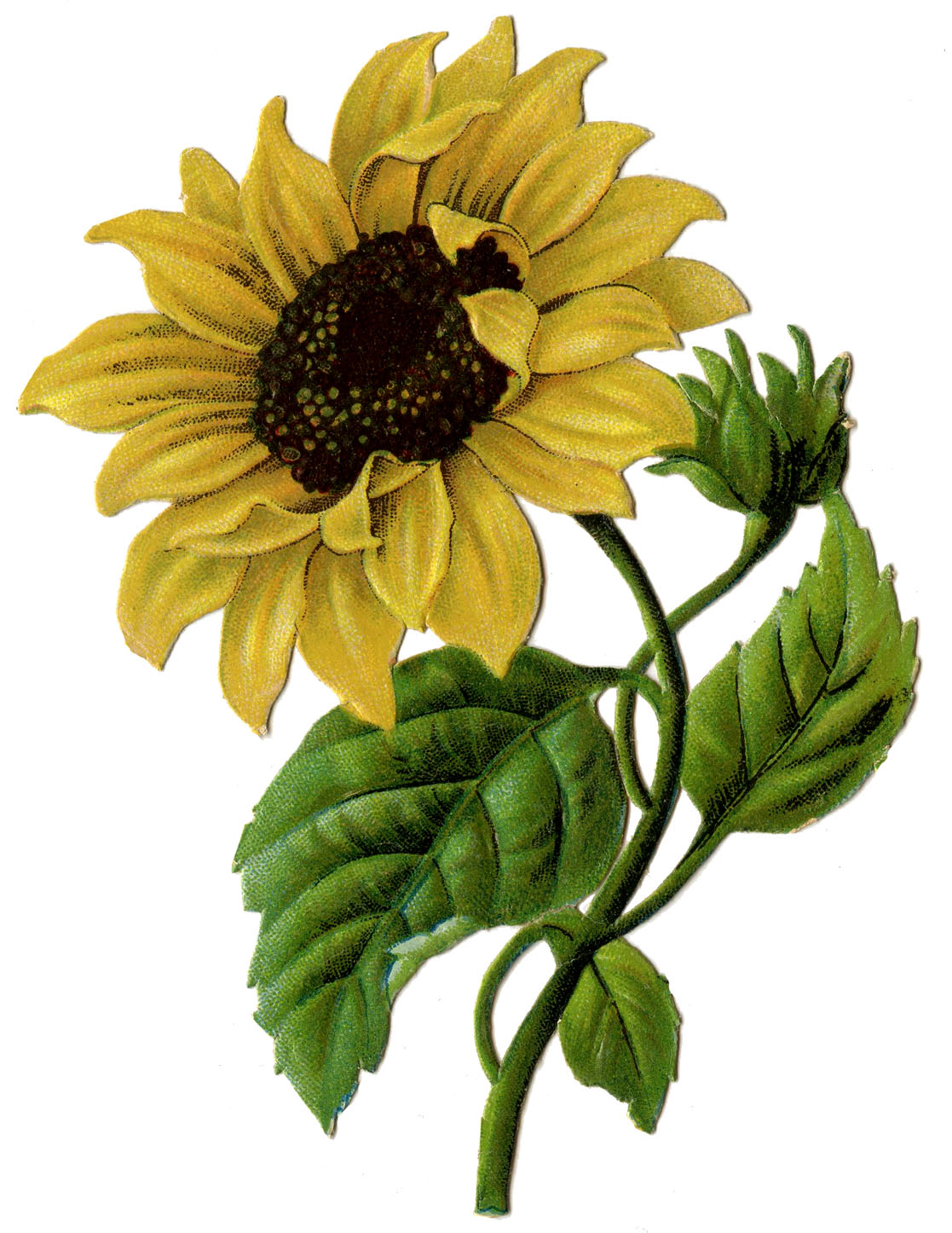
To celebrate the festivity of Autumn, we will focus on Autumn fruits. One of the most representative of them is the sunflower.
The sunflower, or Helianthus anuus, belongs to the asteraceae family of flowers. It is an annual flower very famous for its extremely large and vivid yellow blooms. These plants are widely cultivated all over the world as ornamentals, food plants (their dried seeds can be eaten or used in cooking) and for their valuable oil.
In the Greek Mythology we can find the story of how the first sunflower was born. it is the story of Clytie, a water nymph who feel in love with Apollo, the son a Zeus. Watch the film to discover the whole story.
Vincent Van Gogh
 Vincent van Gogh was
born on March, 30th 1853 in a village in the southern Netherlands. He spent his
young adult life working for art dealers. In 1880 Vincent decided to become a
painter. In the beginning, van Gogh limited his color pallet to dark
colors. When he visited Paris his style changed, incorporating brighter colors
and developing a style that was unique. Van Gogh worked hard, and
produced more than 2,000 paintings, drawings and sketches in the last
ten years of his life. His best-known works were created in the last two years,
a time in which he suffered from mental illness which eventually led
to his suicide. Vincent van Gogh died on July 29, 1890.
Vincent van Gogh was
born on March, 30th 1853 in a village in the southern Netherlands. He spent his
young adult life working for art dealers. In 1880 Vincent decided to become a
painter. In the beginning, van Gogh limited his color pallet to dark
colors. When he visited Paris his style changed, incorporating brighter colors
and developing a style that was unique. Van Gogh worked hard, and
produced more than 2,000 paintings, drawings and sketches in the last
ten years of his life. His best-known works were created in the last two years,
a time in which he suffered from mental illness which eventually led
to his suicide. Vincent van Gogh died on July 29, 1890.
For more information about van Gogh:
Adverbs of Frequency

Adverbs of Frequency are adverbs of time that answer the question "How frequently?" or "How often?". They tell us how often something happens.
Frequency
|
Adverb
|
Example
|
100%
|
always
|
I always go to bed at 11pm.
|
90%
|
usually
|
I usually walk to school.
|
×70%
|
often
|
I often surf the internet.
|
×50%
|
sometimes
|
I sometimes go to the cinema.
|
0%
|
never
|
I never swim in the sea.
|
Adverbs of frequency are put directly before the main verb. If 'be' is the main verb and there is no auxiliary verb, adverbs of frequency are put behind 'be'.
Subject
|
auxiliary/be
|
adverb
|
main verb
|
object, place or time
|
I
|
often
|
go swimming
|
in the evenings.
| |
He
|
doesn't
|
always
|
play
|
tennis.
|
We
|
are
|
usually
|
here in summer.
|
On-line exercises to practise adverbs of frequency:
- Adverbs of frequency Quiz
- Position of adverbs of frequency 1
- Position of adverbs of frequency 2
- Sentences with adverbs of frequency
- Fill in the gap: adverbs of frequency
- Adverbs of frequency order
Subscribe to:
Posts (Atom)

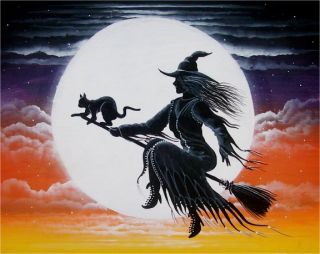

.jpg)
